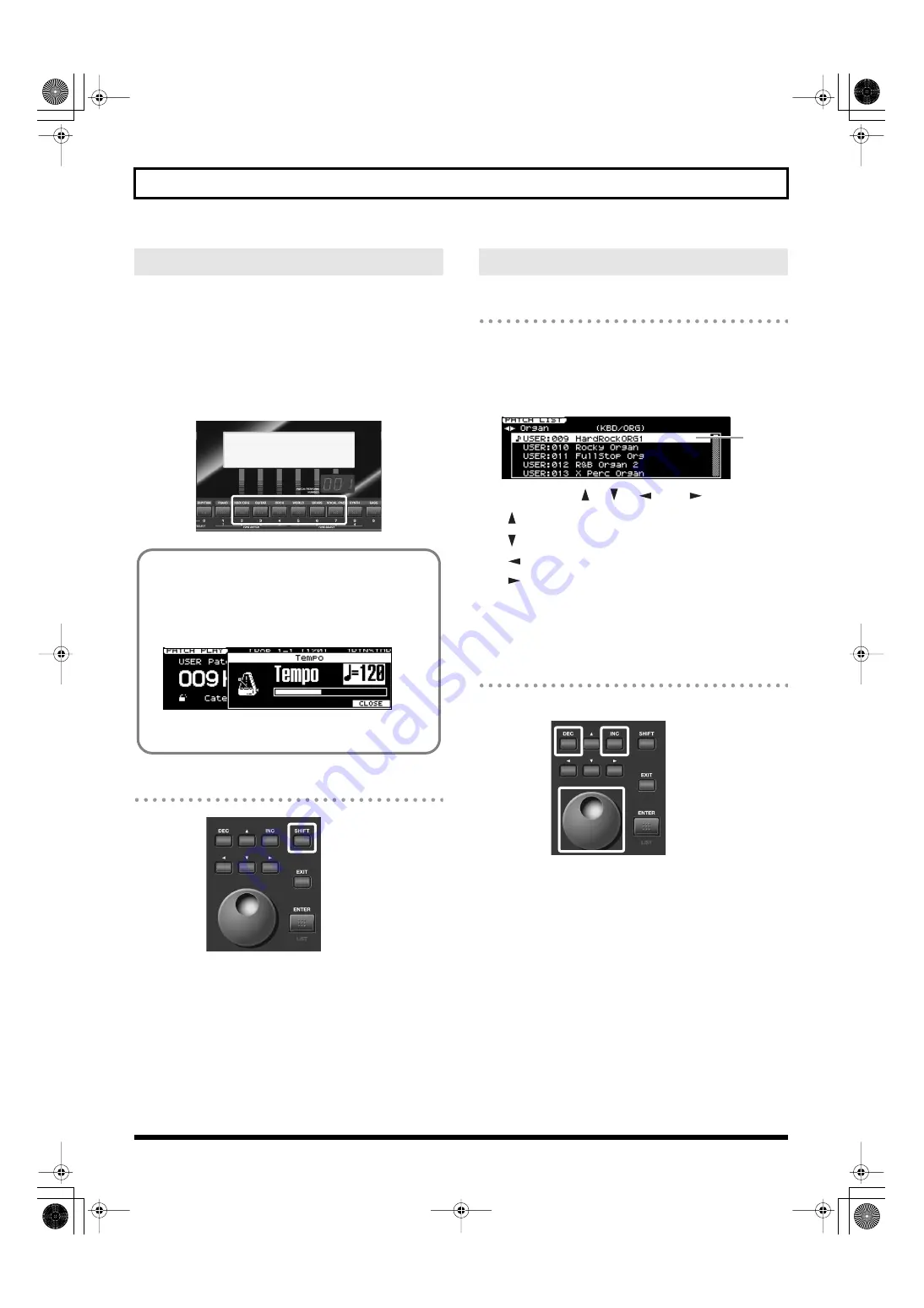
43
Chapter 1. Overview
The six [KBD/ORG/2]–[VOCAL/PAD/7] buttons located below the
display execute various functions (function buttons), and their
operation will differ depending on the screen. The functions are shown
in the bottom of the screen, and the corresponding function buttons
will light.
* When indications such as [7 (EXIT)] appear in this manual, the
numeral indicates the button name, and the text in parentheses
indicates the function name displayed in the screen.
fig.FButtons
[SHIFT] Functions
fig.VALUE
By holding down [SHIFT] and pressing another button, you can access
the screen for making settings related to that button. (In other words,
[SHIFT] provides a shortcut to the corresponding screen.)
For example, if you hold down [SHIFT] and press [SOLO SYNTH], the
Solo Synth setting screen will appear.
For details, refer to the page where a particular function is explained.
In some screens, pressing [SHIFT] will change the operation of the
function buttons. In this case, pressing [SHIFT] will change the name of
the functions displayed at the bottom of the screen. To execute a
function, hold down [SHIFT] and press the corresponding function button.
Moving the Cursor
A single screen or window displays multiple parameters or items for
selection. To edit the setting of a parameter, move the cursor to the
value of that parameter. To select an item, move the cursor to that
item. When selected with the cursor, a parameter value or other
selection is highlighted.
fig.CursorScreen
Move the cursor with [
], [
], [
] and [
] (cursor buttons).
[
]: moves the cursor up.
[
]: moves the cursor down.
[
]: moves the cursor to the left.
[
]: moves the cursor to the right.
If you hold down one cursor button while you also press the
cursor button for the opposite direction, the cursor will move more
rapidly in the direction of the first-pressed cursor button.
Changing a Value
To change the value, use the VALUE dial or [DEC] [INC].
fig.VALUE
VALUE Dial
Turning the VALUE dial clockwise increases the value,
counterclockwise decreases the value.
The value will change in larger steps if you hold down [SHIFT] while
turning the VALUE dial.
[INC] and [DEC]
Pressing [INC] increases the value, and [DEC] decreases it.
• Keep the button pressed for continuous adjustment.
• For faster value increases, keep [INC] pressed down and press
[DEC]. For decreasing value faster, keep [DEC] pressed down
and press [INC].
• The value will change in larger steps if you hold down [SHIFT]
while you press [INC] or [DEC].
About the Function Buttons
Window
The somewhat smaller screens that appear temporarily on the
normal screens are called windows. Various types of windows
appears according to the situation. Some display lists, others
allow you to make settings, and still others ask you to confirm an
operation.
fig.Tempo
Press [EXIT] or [7 (CLOSE)] to close the window. Some windows
will close automatically when an operation is performed.
Editing a Value
Cursor
JUNO-STAGE_e.book 43 ページ 2008年10月17日 金曜日 午後12時27分
Содержание Juno-Stage
Страница 1: ...5 1 0 0 0 0 0 0 4 0 0 2 JUNO STAGE_Cover_e1 fm 1...
Страница 13: ...13 Introduction JUNO STAGE_e book 13...
Страница 17: ...17 MEMO JUNO STAGE_e book 17...
Страница 23: ...23 Quick Start JUNO STAGE_e book 23...
Страница 37: ...37 Reference JUNO STAGE_e book 37...
Страница 157: ...157 Appendices JUNO STAGE_e book 157...
Страница 253: ...For EU Countries For China JUNO STAGE_e book 253...
Страница 256: ...5 1 0 0 0 0 0 0 4 0 0 2 JUNO STAGE_Cover_e1 fm 1...






























